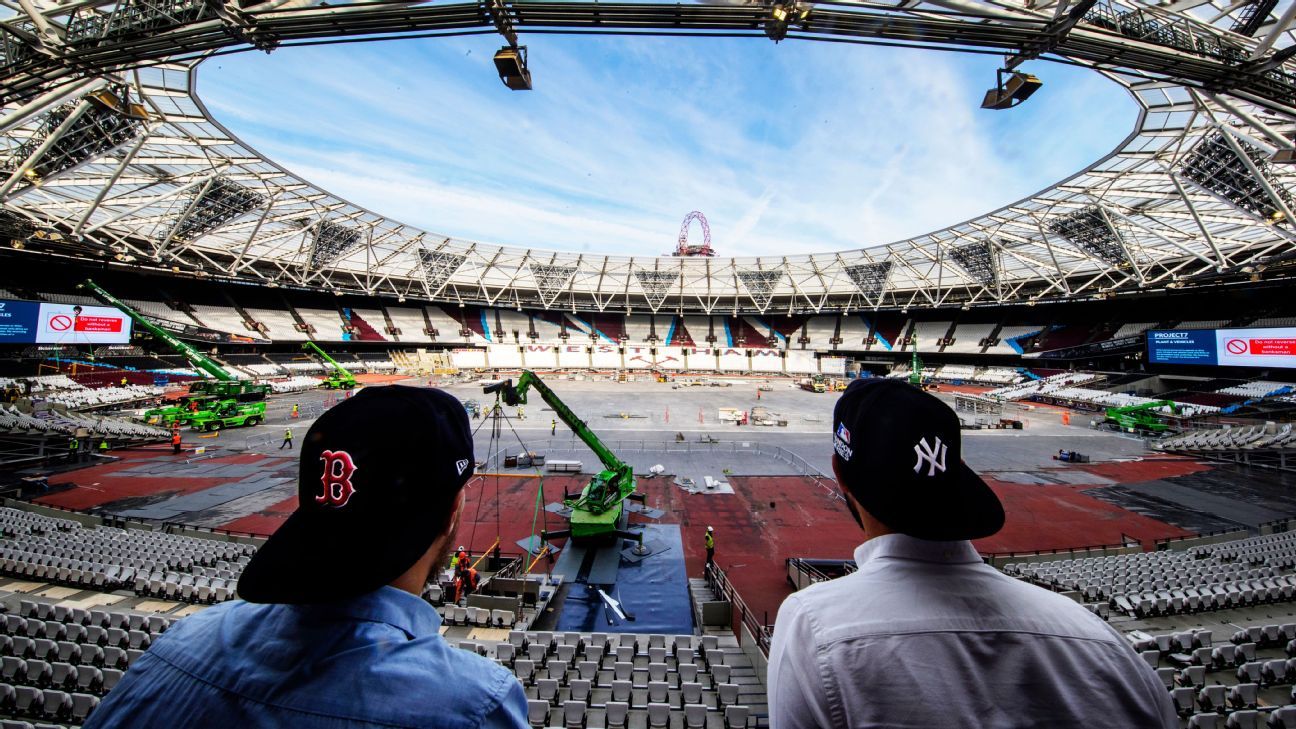What do Winston Churchill, Freddie Mercury, Henry VIII and the Loch Ness Monster have in common?
They are not only some of the most recognizable names from British lore, they will also be prominently featured during the London Series between the New York Yankees and the Boston Red Sox, as Major League Baseball is pulling out all the stops in bringing America’s pastime across the pond for games Saturday and Sunday.
“We’re going to do a race, the way it’s done with the presidents at Nationals Park,” Jim Small, senior vice president of Major League Baseball’s international business, told ESPN. “What we did is we ran a contest with our social media and those were the four winners, and they’re going to race. That shows the wonderful humor that exists there.”
The Presidents Race is held at every Washington Nationals home game in the middle of the fourth inning, and it’s one of the best-known in-game entertainment events across MLB, alongside other mascot competitions such as the Milwaukee Brewers‘ Racing Sausages.
Another popular race that will be making its way to London Stadium involves “The Freeze,” who will be competing against a fan in a foul-pole-to-foul-pole race along the warning track at London Stadium, the way the Atlanta Braves “superhero” has been doing in his iridescent powder-blue bodysuit since 2017.
“There are a lot of small details that come with playing these games,” Small said. “For instance, we have 700 [local] volunteers that will help the regular ushers and ticket takers to help explain baseball. We taught them how to sing ‘Take Me Out to the Ballgame,’ so they can lead their section into singing the national anthem of baseball.”
MLB is aiming to find the right balance between the fun and quirky aspects that surround baseball games in North America, while at the same time not dumbing down the game for knowledgeable baseball fans.
“In-game, we are going to do some things that we know we need to do to teach the game. We’re going to have a live announcer that will explain the little nuances that go into a baseball game,” Small said. “On the scoreboard, instead of R-H-E, it will say ‘Runs,’ ‘Hits’ and ‘Errors’; we can’t assume everybody will know what R-H-E is. We’re going to do an homage to what we do, and how special it is to go to a major league game. We’re going to have the crew do the Y-M-C-A [routine, to the classic Village People tune] the way they do at Yankee Stadium, and we are going to play ‘Sweet Caroline’ [as they do at Fenway Park].
“But it’s important to strike a balance. There is a hardcore baseball fan base in the U.K., and they badge themselves proudly as baseball fans. They stay up late to watch our games. … For the hardcore baseball fan, this gives them a chance to validate themselves.”
These are among the details MLB has learned in its forays into nontraditional baseball venues — that it needs to teach fans little things that people who grew up around baseball take for granted, such as being able to hold on to any ball that makes its way into the stands.
“When we played in ’93, a perfect example was there was a foul ball in the stands and they threw it back,” Murray Cook, MLB’s senior field coordinator and consultant, said. “Because that’s what they do in cricket, they play with the same ball the whole game. It had to be announced that you get to keep the baseballs. Same thing happened in Australia. We informed people if the balls go into the stand you can have them, don’t throw them back in the field. It’s a souvenir.”
The 1993 game Cook referred to marked the most recent time MLB-sponsored games were played in Europe, part of a rain-shortened exhibition series between Red Sox and Mets minor league squads held at The Oval, one of the largest cricket grounds in England.
Bringing regular-season MLB games to Europe has been an enterprise for Small, Cook and their extensive team of collaborators for the better part of two decades. One of their biggest challenges was finding a location with the dimensions to hold a baseball field.
“What fits is No. 1, and the orientation of what’s there,” Cook said. “Ovals are big, but venues that have a soccer pitch and also have a track-and-field venue are larger in size. So we started looking for those type of venues, and the London Stadium became pretty prominent. In 2013, we started looking, in 2014 we looked a little harder, and then started looking at just ideas and here we are.”
“The challenge for our sport is that you can’t fit a baseball field into a soccer stadium,” Small said. “The NFL has had a lot of success there, but they’re very fortunate that the footprint for a football game fits perfectly into a soccer stadium. We needed the extra little bit that comes with it being a multipurpose track and field and soccer facility, which barely allows us to put that footprint down. We wanted to play there for a long time, but it was important, finding the right venue in the right place.”
Cook and his 150-strong staff have had to build their “ballpark-in-a-box” from scratch in just 23 days, importing a lot of the materials, including 340 tons of clay from Slippery Rock, Pennsylvania, and 50 tons of FieldTurf manufactured in Auchel, France. Cook explained his team had to use the artificial turf because it was simpler in terms of logistics, having to build the entire ballpark on top of an armored deck that protects the West Ham United Football Club pitch underneath.
“Under the armor deck is the track-and-field venue and this multimillion-dollar soccer pitch; we can’t anchor or dig any holes,” Cook said. “So everything has to be balanced or weighted to support all the fencing structure and foul poles. So we have a lot of weight out there. For example, the left and right foul poles have a large concrete [base] that we have to use because we couldn’t put a pole in the ground. Dugouts, bullpens, batter’s eye, field, fencing, padding, locker rooms, warning tracks, all the things you see, everything in 23 days, and we got this ‘ballpark-in-a-box’ idea coming to fruition.”
The end result will have some interesting dimensions. The field will be 330 feet down each foul line, and it will have a distance of 385 feet to center field, which will feature a 16-foot wall. Cook also said it would have an expanded, “Oakland-like” foul territory, referencing the Athletics‘ Oakland Coliseum expanse.
“It will be very similar to Toronto’s and Tampa’s infield where they have an all-clay infield area. It will look just like a regulation infield,” he said. “Because of the layout of the seating-bowl structure, it’s interesting with the extra dynamics. The foul territory is a little larger than your typical foul territory, which is good for the pitchers. Then you got a little shorter center field, where it’s not good for the pitchers. The fact that the venue is built to Olympic standards and there is very little or any air movement, this could eventually affect the flight of any long-hit balls. So it’s a good balance.”
Cook called the center-field wall informally a “mini Green Monster,” in homage to the 37-foot-high wall in left field at Fenway Park. At just 385 feet to dead center, it will be one of the shortest center fields on record for an MLB regular-season game, which could tempt the power hitters in the Red Sox and Yankees lineups used to the average of 402.6 feet across MLB’s 30 ballparks. Nonetheless, Small is content with the dimensions, which he called “embracing the quirkiness of our game.”
“We would love to have had the traditional dimensions of a major league park, but for example, Yankee Stadium in right field is not traditional. Fenway Park in left field is not traditional. So not necessarily by design, but by necessity, we’re replicating some of the great things about baseball,” he said. “Every basketball court is the same size, but not every major league ballpark is the same size. Those little idiosyncrasies make our game special and unique. It gives us an opportunity to tell a story, and having that center field be a little bit different than it normally is, is part of that narrative and part of that story.”
Protective netting was also an important issue addressed when building the ballpark, with Cook stressing that his team has implemented netting that “is the largest you’ll ever see in any major league ballpark.”
MLB is also optimistic that the infamous London weather will not put a damper on the celebration. The ever-changing forecast currently calls for overcast skies and temperatures close to 80 degrees for the series, with no heavy rainfall in sight.
“The field drains great, and all the rain, which at times has been significant, didn’t hamper our ability to put the field together so that portends well for us,” Small said.
‘Old Rivalry, New Ground’
Major League Baseball is marketing the series at London Stadium as “Old Rivalry, New Ground” a nod to the rivalries of the English Premier League. In an attempt to make baseball more appealing to the European fan, MLB marketing efforts have gone beyond just logos and names, making hot dogs and Cracker Jack available, as well as having vendors in the stands.
“There is no vending in the stands at London Stadium, so for the first time there will be. … Bringing beer out, bringing hot dogs out is something that has never been done there, so we’re going to do things like that,” Small said. “Concessions will be a total mix. It will be things that fans expect to have when they go to traditional EPL matches, but they’ll also have food like hot dogs, among other things, which are not traditional. It’s a celebration of the two cultures coming together.”
Major League Baseball also hopes to get people who are not familiar with the sport to start tying the logo to a face and a name, and to become not only baseball fans but start identifying with certain players.
“This is the tip of the sword. We’ve been doing this stuff for 25-plus years, and specifically investing for the last 10-15 years,” Small said. “It shouldn’t be a surprise that one of the best players, on arguably the best team in baseball, is [the Twins’] Max Kepler, who was born in Berlin, and who was touched by our program. We have 24 players from Europe playing in our minor leagues, and they’re not from traditional places, they’re from Russia, Moldova, Lithuania; we’re starting to see more high-end development.”
Small also told ESPN that two other major European cities have already shown interest in hosting major league games. The subject is slated to be discussed during negotiations for the next collective bargaining agreement with the players’ union.
“We expect an uptick, with what Max is doing this year, in Germany. What we’re trying to do with baseball around the world, to a kid in China, to a kid in India, where we’re getting ready to start opening doors there soon, or in the U.K., or throughout Europe, we want to give them permission,” Small said. “If a kid hasn’t played baseball before, they can be exposed to the game through something big like this. If they have played baseball before, that’s even more important because they can say: ‘See this huge event that’s coming in town, this is my sport, this is my team, the Yankees are my team, the Red Sox are my team.'”

